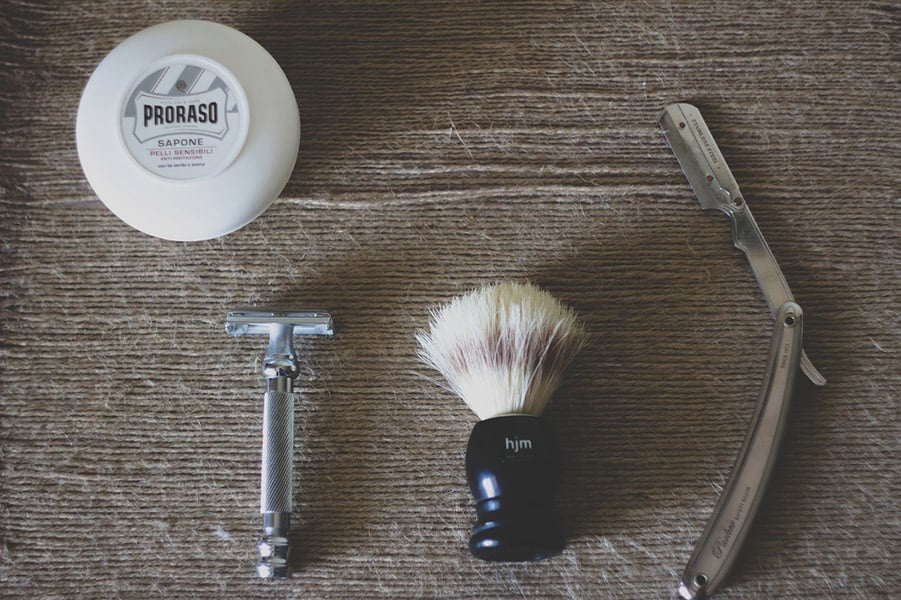
One of the biggest culprits of plastic waste in the bathroom comes from shaving. The shaving industry, worth more than 10 billion dollars, promotes the quick and easy convenience of shaving with disposable razors or multi-blade cartridges.
In the early ’90s, the US Environmental Protection Agency estimates more than 2 billion of these disposable razors and cartridges end up in landfills each year. We can only guess how much that number has risen in the last 30 years. Fortunately, for the sake of the environment, there are ways you can make your shaving routine eco-friendly. And it starts with taking a step back in time.
So, how can you make your shaving routine eco-friendly?
The Safety Razor
Take a trip back in time. Back to a time before disposable plastic razors or multi-blade cartridges. In the early 20th century, the safety razor was popularized. It represented a safe and effective method of wet shaving, instead of using a straight razor blade. With the advance of shaving technology in the 1980s, commercial shaving brands popularized disposable multi-blade cartridges as a way to increase profits and make the shaving experience quick and easy.
Unfortunately, quick and easy doesn’t mean better.
A disposable cartridge razor is only designed to be used 5-10 times before being thrown out. Covered by a plastic cartridge, these multiple blade razors are not recyclable or biodegradable. So when they get tossed out, they end up just sitting in a landfill taking years upon years to decompose.
Thinking of saving some money by extending the life of your cartridge razor and using it a few more times? Think again. Due to the multiple blades stacked upon one another, they can easily harbor moisture which then brings in bacteria. Each time shave, you are exposing your skin to any potential germs that are lurking between the blades.
Recently, there has been a push by both women and men who are looking for a more eco-friendly way to go about their shaving routine. The safety razor has now risen back into popularity.
Usually made from stainless steel or chrome alloy, a safety razor is durable and can last a lifetime. A single double edge razor equips to a closed comb-like head held by a solid tubular metal handle. Many safety razors feature a polished chrome-plated finish which is a beautiful piece of sleek design.
The best part about safety razors is that they are eco-friendly as the blades are fully recyclable. Just use a razor blade bank, which is available for cheap from most online retailers, as a safe way to store your used up safety razor blades until they are ready to be recycled.
A safety razor is also more affordable than disposable cartridge razors. Consider the costs:
- Safety razor = $20-40
- Replacement blades = $10 (100 count)
- Cartridge razor = $10-20
- Replacement cartridges = $35 (12 count)
We’ll let you do the math. Not only are you saving yourself money you are also reducing your plastic waste.
Why Use a Safety Razor?
Apart from just saving money and reducing their environmental impact, people have made the eco-friendly switch to using a safety razor have done so for several other benefits:
- A better shave – each time you shave, you are passing your skin with a blade. Now cartridges with multiple blades may seem better, but in reality, it means more blade passes on your sensitive skin. This means more skin irritation, shaving bumps, ingrown hairs, and cuts. A safety razor has one blade and due to the weighted design of the razor, you actually have more control and precision during your shave.
- A cleaner & safer shave – multiple blade cartridges can trap in moisture and accumulate dead skin, which can harbor bacteria. When you shave your skin, your open pores will be exposed to germs to enter. This can be a recipe for infection and skin irritation.
- Better for thick hair – despite having multiple blades, cartridge razor blades just aren’t sharp enough to cut through thick hair no matter what shaving cream or gel you use. It also results in clogging of your razor and irritation on your skin when you have to make multiple passes because the blades are sharp enough
- Traditional – newer technology doesn’t always mean better. Wet shaving with a safety razor transforms you back to a time where daily tasks were done with deliberate practice and patience. Go nostalgic and shave just like your grandparents did.
- Enjoyable – proper wet shaving with a safety razor is an art. There is a small learning curve and it does take more time but you will start to enjoy your shaving experience much more while you turn it into a meditative and relaxing ritual to start off your day.
How to Use a Safety Razor
Here are some guidelines for using a safety razor for the first time. These can be used for shaving either your face, legs, or other parts of the body.
Prep & Lather
You first need to exfoliate your skin. The easiest way to do this is to take a hot shower. This will loosen up your hair and pores in your skin. If you are shaving your legs you can scrub the skin to remove any dead skin cells. Leaving dead skin cells can cause ingrown hairs and skin bumps when the razor pushes dead skin cells into a pore.
Apply your favorite shaving lotion or cream. We recommend using an eco-friendly shaving cream that is all-natural, free from synthetic chemicals and derived from plant-based ingredients. Use an eco-friendly shave brush, which creates a richer, thicker, and creamier lather which will further allow your skin to exfoliate. Just make sure it’s vegan and the bristles are not animal-derived from badger or horsehair.
The Shave
Shaving is an art. So when starting to use a safety razor for the first time, your focus should be on going slowly. If you cut yourself, don’t blame the blade but instead take it as feedback you should shave more slowly and carefully.
Maintain a 30-45 degree angle between the blade and your skin. At this angle, the rounded head and tip of the blade should rest easily against your skin. This will give you control and also allow the weight of the handle to guide the razor. Do not hold the blade perpendicular to your skin and drag. This will result in a lot more than just hair coming off on your blade!
Use short gentle strokes as you shave, rather than dragging the razor across a large section of your skin. Shave along with the grain of your hair and not against it for your first pass. Take extra care for all those hard to reach spots on your neckline. For the legs, go carefully around your ankles and behind the knees.
Don’t apply pressure when shaving. A safety razor blade is sharp enough to do the job on its own, so only a light touch is needed. If your skin isn’t too sensitive you can reapply your shaving cream and go for another round to get any spots you may have missed. You can also shave across or against the grain of your hair this time but remember, a slow and steady shaving experience will give you that silky smooth shave you desire.
Post-Shave
Wipe your skin with a warm towel and then press your skin with a cold towel or rinse with cold water to close any pores that may be opened. If you have an alum block, you can run it under cold water and apply directly to your skin to soothe and clear out your pores. This will stop any small nicks or cuts that are bleeding but may sting a bit.
Final Thoughts
After a shave, we all want the same thing: smooth, clean, and healthy skin.
A simple switch in your bathroom routine will make a difference in reducing your plastic waste. It will also give you the true satisfaction of a high-quality wet shave. There are many other simple routines in the bathroom that can result in a positive change for your health and also the environment. Once you make one switch, you will find that make more eco-friendly changes comes even easier.
We hope this guide has been helpful to you as you enter the world of eco-friendly wet shaving. We wish you an enjoyable clean shave!



